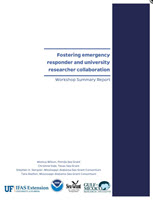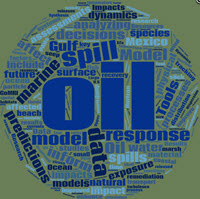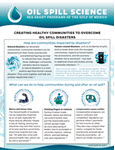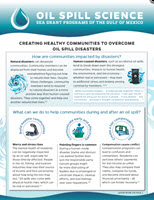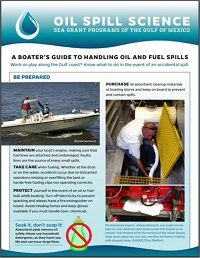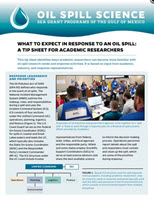
The Sea Grant Oil Spill Outreach Team released a tip sheet that discusses how academic researchers can become more familiar with priority oil spill research needs and with protocols for collecting data during response activities.
Using feedback from academic, industry, and response representatives, the publication offers specific recommendations for actions that academic researchers can take prior to a spill event so that they can better meet the response community’s needs as a spill unfolds.
Read What to Expect in Response to An Oil Spill: A Tip Sheet for Academic Researchers to learn more about recommendations for developing an oil spill research plan and about the organization of response efforts as outlined in the Oil Pollution Act of 1990 .
Check out these Sea Grant publications for more information about oil spill response:
- Fostering Emergency Responder and University Researcher Collaborations
- Federal Emergency Response Framework for Oil Spills: Stafford Act and Oil Pollution Act
Read these articles to learn how scientific teams responded to oil and gas events:
- Scientists Coordinate Research with Responders in Santa Barbara Oil Spill
- Scientific Dream Team Conducts Rapid Response Research at Hercules Gas Blowout
- GoMRI Science Teams among First Responders to Galveston Bay Oil Spill
The Sea Grant Oil Spill Outreach Team synthesizes peer-reviewed science for a broad range of general audiences, particularly those who live and work across the Gulf Coast. Sea Grant offers oil-spill related public seminars across the United States.
Information about upcoming Sea Grant science seminars and recently held events is available here. To receive email updates about seminars, publications, and the outreach team, click here.
By Stephanie Ellis. Contact sellis@ngi.msstate.edu with questions or comments.
************
GoMRI and the Sea Grant programs of the Gulf of Mexico (Florida, Mississippi-Alabama, Louisiana, and Texas) have partnered to create an oil spill science outreach program.
The Gulf of Mexico Research Initiative (GoMRI) is a 10-year independent research program established to study the effect, and the potential associated impact, of hydrocarbon releases on the environment and public health, as well as to develop improved spill mitigation, oil detection, characterization and remediation technologies. An independent and academic 20-member Research Board makes the funding and research direction decisions to ensure the intellectual quality, effectiveness and academic independence of the GoMRI research. All research data, findings and publications will be made publicly available. The program was established through a $500 million financial commitment from BP. For more information, visit http://gulfresearchinitiative.org/.
© Copyright 2010-2020 Gulf of Mexico Research Initiative (GoMRI) – All Rights Reserved. Redistribution is encouraged with acknowledgement to the Gulf of Mexico Research Initiative (GoMRI). Please credit images and/or videos as done in each article. Questions? Contact web-content editor Nilde “Maggie” Dannreuther, Northern Gulf Institute, Mississippi State University (maggied@ngi.msstate.edu).

